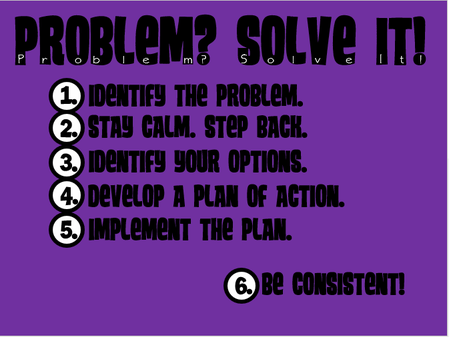 Ok cheesy title I know... but today I absorbed SO MUCH great information from a wonderful team of teachers and I wanted to sum it up to share with all of you. It is a given that any and every elementary campus faces problems on a daily basis, some bigger than others of course, but nevertheless a problem is sure to arise. When faced with a problem-no matter how small, it is good to be equipped with the knowledge of what to do and how to make the problem a beneficial learning experience for all parties involved. Through several conversations and situations, I was able to contemplate the process in which a problem is solved... Step 1: Obviously, you need to figure out what the problem is and why it is a problem. Step 2: It is always beneficial to remove yourself from the situation and look at it from an outsiders point of view. With unbiased eyes you will be able to ask yourself "is this really a problem?" or "is this a problem I can fix on my own? Do I need assistance in coming up with a solution to this problem?" Jumping to conclusions never helped anyone- and I am beginning to seriously realize the importance of evaluating a situation. Step 3: After determining the magnitude of the problem, it is good to determine what you are capable of doing to solve the problem... this is when you would decide if you need to solicit help, or if you have it under control. Think about what you are able to do, what is appropriate to do, and what are the most important and beneficial steps to take. Step 4: This is my favorite part. Develop a plan of action. Construct a well thought out model of how you propose the issue be resolved. Sure for smaller problems this wouldn't be put to paper or anything, but for those hefty troubles that require quite a doozy of a plan, it is important to get your thoughts clear and concise so that the plan can be carried out in a way that benefits all parties. Step 5: Well you developed the plan...so.... MAKE IT HAPPEN. Put the plan into action and watch your ideas unfold. If the plan flops then you have two options: A) Hang up your hat-Owell you tried. or B) Reflect on why your plan did not produce the outcome you so desired. If the solution is worth fighting for then reevaluate your options and devise an edited version of the plan to implement. Step 6: BE CONSISTENT! I hear this word- consistent- OVER AND OVER again and to me, that makes sense, because consistency is the key to making a change. (HA! I consistently hear the word consistent!) To me, if you plan on making a change, it does not make sense to say one thing and then do another, or to just give up after your plan doesn't immediately work. Staying consistent is the way to build a routine and backbone to base decisions off of. With a plan that is implemented consistently, there is always a way to come up with a solution and there are rarely any questions or vague expectations of what is to happen. I need to remember to always set clear, understandable expectations and follow through- this will lead me to the development of a distinct set of guidelines to solve any problem I may face.
1 Comment
|
AuthorI'm just an Elementary Nerd sharing my excitement for the classroom! Blogs to check out:Weekly Updates:Favorites:Archives:
November 2017
Follow Me! |






 RSS Feed
RSS Feed
